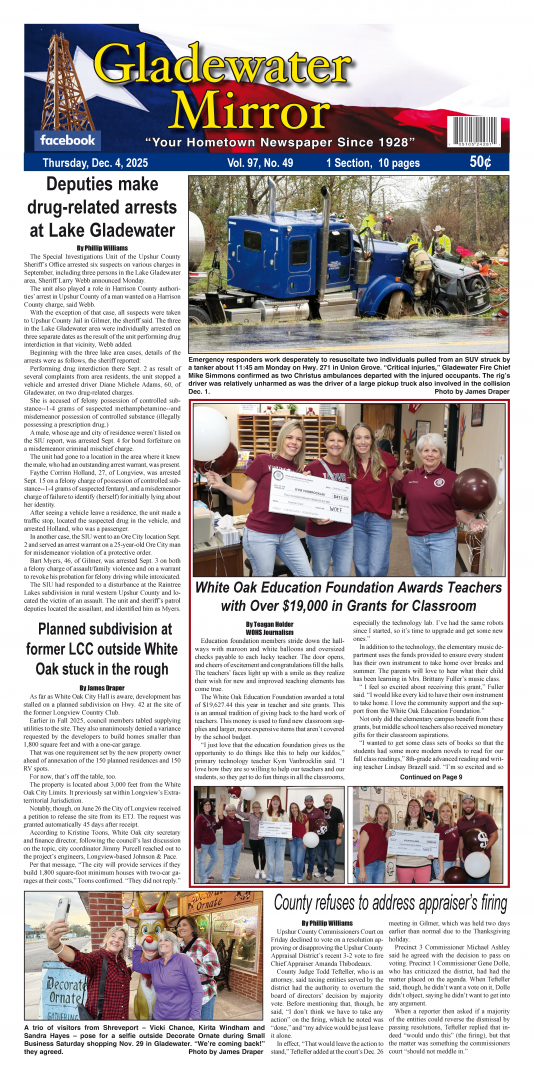There’s sound logic behind Gladewater’s double-redundancy at the water treatment plant, and precautions are currently being put to the test by a pair of malfunctioning pumps.
It puts the city in a precarious position for at least another week, maybe two, possibly more as the last of three pumps toils away to keep water flowing to residents.
Gladewater’s million-gallon clearwell has a trio of mountings attached to the below-ground storage tank, but only one rack’s in use after back-to-back breakdowns March 1. The water plant’s operators are literally losing sleep over it, using their remote monitoring to keep round-the-clock watch on their last workhorse.
It’s a tense end to Wendy Emmel’s first year as plant manager at the East Lake Drive facility.
Putting it simply, “That’s the pump we use to send water through town,” and it won’t get a break until backup’s in place again.
All things considered, there are long-shot options should the surviving pump need help in a pinch – a mobile pumping unit’s a possibility, if one can be tracked down, and other contingencies are being explored.
For now, though, it’s a waiting game.
The community has one water source, Lake Gladewater, and one path to get that water treated, into the system and into homes. The city uses about 750,000 gallons on an average day; in addition to the clearwell’s capacity, two water towers hold 300,000 and 350,000, respectively, at stated capacity.
All three of the plant’s pumps were installed in 2010. All three have seen key upgrades in the past nine months, including new Variable Frequency Drives for two and a new VFD fan for the other. It came as a shock earlier this month when not one but two pumps locked up in turn. Both pumps and motors were pulled and sent off for repairs March 4.
“They are actually replacing the pump shafts in each one – the vibrations got so bad,” Emmel said. “When they get back here, I plan to have them pull that last one just to check it out since it’s been running this whole time.”
She’s a by-the-manual, best practices kind of person. Guidelines recommend rotating workload between the pumps to extend their lifespan through regular usage and regular downtime along with a consistent maintenance program. That wasn’t necessarily the case in prior years, but it’s become the new order of business for Gladewater’s operation.
Emmel estimates the trio of pumps have another five to seven years left in them with regular TLC.
“Typically, they get pulled or replaced between 10 and 20 years. That’s a big gap,” she added. “You run them until you can’t. You do that according to the availability of supplies, equipment, parts…”
It’s not the kind of hardware where a backup can be waiting in the wings for use in an emergency.
“They don’t have them on a shelf anywhere. Those pumps are built to order. Anybody can repair them, but you have to go to the manufacturer to get them made. If you’re ordering a brand new one they have to build, that can be 8 weeks to 12,” Emmel said. “That’s the purpose of three – if you lose one, you still have one in use and one that’s backup.
“They all wear at the same time. You can be proactive in trying to get them repaired before you have a problem.”
Gladewater’s plant is a 24/7 setup. While the current tech at the site doesn’t allow for 100 percent remote control, Emmel and operator Nate Palmer can at least keep on eye on things from home and head in when necessary. They’re connecting their mobile phones and laptops for after-hours monitoring right now and crossing their fingers for smooth running until, best case, the pump shafts are repaired and the equipment’s put back in place at some point next week.
Needless to say, “I am ready for them to get here.”
– By James Draper









